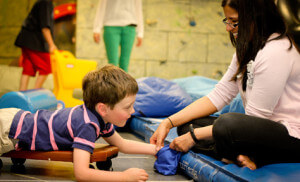 As an important part of early childhood, elementary, and secondary education, many students and prospective professionals consider what an occupational therapist does in school environment roles when making decisions on a career path. Occupational therapy falls under the umbrella for specialized education services within a school setting, offering help and assistance to students in a number of ways.
As an important part of early childhood, elementary, and secondary education, many students and prospective professionals consider what an occupational therapist does in school environment roles when making decisions on a career path. Occupational therapy falls under the umbrella for specialized education services within a school setting, offering help and assistance to students in a number of ways.
Observations for Intervention
Much of a school occupational therapist’s time will be spent in identifying the students who are in need of assistance and additional programs to support the educational process. Among the areas in a school environment where the therapist will observe the student are the classroom, cafeteria, physical education class, and recess playground. The observations are normally over a course of several hours, preferably on different days, and at various times of the day. Next, the occupational therapist meets with parents, teachers, and administrators to discuss observations, documentation, and determinations for the types, if any, of occupational therapy from which the student will benefit. If need is determined, this meeting will result in what is termed an Individualized Education Plan (IEP).
Making observations and preparing documentation are crucial skills in the every day tasks of an occupational therapist in a school environment. Additional information on skills and education required for qualifying for a position as a school occupational therapist can be found at the website for the American Occupational Therapy Association.
Working with Students on Fine Motor Skills
Typically, therapists conduct exercises with students who need help on fine motor skills and set up a home exercise regiment for parents to help them improve their child’s fine motor skills in addition to what is received at school. Fine motor skills involve cutting with scissors, writing letters within the lines on paper, and putting together puzzle pieces. This is a particularly important step in the process for early childhood and elementary students, along with upper grade level students who have special needs or who have been involved in an accident or similar circumstance where fine motor skill ability has been diminished.
For many students, not having developed fine motor skills can affect everything from writing ability to working with science equipment for experiments. Working with an occupational therapist helps students to gain these skills in order to be able to successfully complete assignments and meet objectives.
Working with Students on Large Motor Skills
School occupational therapists also work with students who need support to develop large motor skills. Skipping, running, and jumping are some of the activities that use large muscles. In addition to the practice and exercise that students get in developing these skills through a physical education class, occupational therapists in schools are able to provide additional opportunities for students to work on the development of these muscle systems.
Evaluation and Re-Assessment
Much like the first steps in observation, occupational therapists in schools will re-evaluate a student’s progress throughout the therapy processes. This might result in developing new strategies to better help a student, continuation of a current plan, or stopping therapy based on improvement.
Related Resource: 504 Plan
Students need a variety of support to be successful and learn. The key services of what an occupational therapist does in school environment roles play an important part in that support system.


